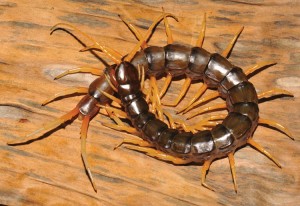Monster Monday: The Swimming Centipede
August 29, 2016
A stream might seem like a great place to get away from biting and stinging bugs in tropical climates. In parts of Southeast Asia, however, it might not be a good idea after all. In June, scientists there announced they had discovered a new species of giant centipede. Unlike other centipedes, however, this species lurks in dark waters and is a powerful swimmer. The scientists published their description in the scientific journal ZooKeys.

Swimming centipede (Scolopendra cataracta)
Credit: Warut Siriwut, Gregory D. Edgecombe, Chirasak Sutcharit, Piyoros Tongkerd, Somsak Panha (licensed under CC BY 3.0)
Centipedes are a group of animals with long bodies and many pairs of legs. Although they vaguely resemble six-legged insects, they are not closely related to them. The narrow bodies of centipedes are divided into many segments (sections) that lie behind each other. Each section has two legs. Some centipedes have only 15 pairs of legs, while others have more than 180 pairs. A centipede’s head includes two antennae (jointed feelers) and a pair of jaws. The first pair of legs behind the head are modified into fangs. Centipedes use these fangs for defense or capturing prey, but not for walking. The fangs are called poison claws because a gland in the head fills them with poison.
The new species of swimming centipede is named Scolopendra cataracta. It is nocturnal (active at night). When it enters the water, it swims with powerful undulations (wriggles) of its body, similar to the way an eel swims. It is found in rivers in the Southeast Asian countries of Thailand and Laos and grows up to 8 inches (20 centimeters) long. Poison from the swimming centipede and its relatives is not fatal to humans, but stings can cause terrible pain in the affected limb for days. The poison is more than adequate to subdue small aquatic invertebrates, which the scientists assume are the swimming centipede’s usual prey. More research must be done, however, to study this animal and learn about its ecology.
The scientists who discovered the swimming centipede think that the nighttime waters of of tropical rivers and lakes hold many more surprises. Such habitats have long been observed during daylight hours, and many of the species that are active during the day have been catalogued. Finding creepy-crawly critters at night, however, can be a bit trickier. Who knows what other new species scientists may find while peering into moonlit waters?


